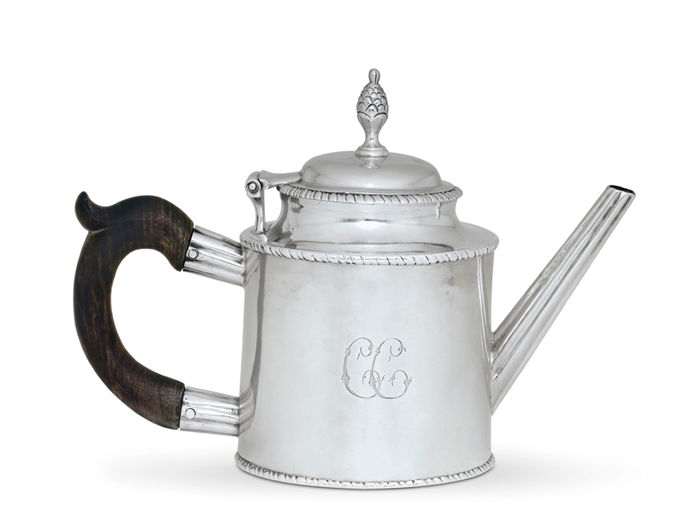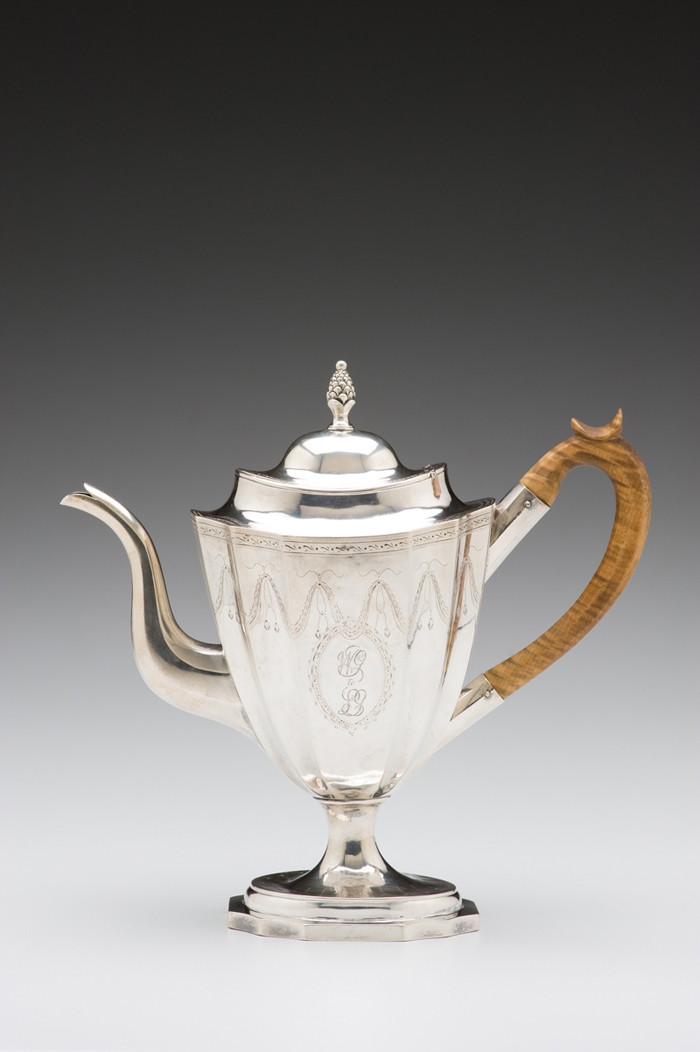“During [Paul Revere’s] protracted life, his activity in business and benevolence, the vigor of his mind, and strength of his constitution were unabated…Seldom has the tomb closed upon a life so honorable and useful.”[i] – Excerpt from Death Notice, Columbian Centinel
At the time of his death, Paul Revere (American, 1734 – 1818) was certainly admired for his contributions to his community. However, less was known about his involvement in the American Revolution. Revere became the national hero we know today after Henry Wadsworth Longfellow published his poem called Paul Revere’s Ride in 1861.[ii] In this celebrated prose Longfellow recounts, with some literary license, Revere’s brave midnight mission in 1775 to warn his fellow patriots that the British were coming.[iii] This endeavor allowed the colonial resistance to better prepare for the first battle of the Revolutionary War.[iv]
When he was not fighting for America’s independence, Revere’s primary focus was his silver shop in Boston which operated for over forty years. He found great success as a silversmith.[v] The shop produced not only large elaborate tea services, but also a variety of useful low-end products or personal items. Today Revere’s hollowware forms are considered some of the best representations of colonial silver. A work by Paul Revere is revered.
The Kamm Collection is fortunate to have two works associated with the Revere name. One is the Goddard Family Teapot c.1811 and the second is a drum-shaped teapot c.1782. For this blog post we will take a closer look at these two extraordinary objects and share some information about Revere’s remarkable life.
The Revere Shop
The history of the shop begins with Paul Revere’s father Apollos Rivoire or Paul Revere Sr. [vi] Rivoire was a French Huguenot who arrived in America as an indentured servant in 1716. He was indentured to the Boston goldsmith John Coney in order to pay for his apprenticeship. Fortunately, this relationship proved to have a fruitful ending. When Coney died in 1722, his young servant was able to purchase his freedom and eventually launch his own smithy.[vii] Rivoire shared his expertise with his son who took over the business after his father’s death in 1754.
Revere inherited “a fully functioning smithy, complete with tools, designs, molds, and customers.”[viii] His daybooks or ledgers reveal that, while he might have had a slow start following his dad’s death, he quickly gained momentum. Initially, Revere relied on a customer base close to home in the North End of Boston. Later, his clientele expanded, particularly, because of his affiliations with groups such as the Freemasons and the Sons of Liberty. Evidence suggests that Revere skillfully grew the business and ultimately became “Boston’s most prolific and entrepreneurial craftsman.”[ix]
The shop was successful because Revere remained flexible throughout his career. He nimbly navigated the changing silver styles, experimenting with bold rococo ornament and executing delicate neoclassical forms. However, this astute businessman never got “swept away” by a particular fashion.[x] In addition, Revere was willing “to meet the needs of colonial Bostonians hailing from various economic strata.”[xi] While he certainly had wealthy clients who commissioned substantial silver works, his business also heavily depended on doing whatever needed to be done. Revere polished and repaired metalwork, produced practical everyday objects such as spoons, buckles, and buttons, engraved copper plates, operated a printing press, and he even acted as the neighborhood dentist. Essentially, he was prepared to try “something new if it meant amusement, a challenge or a paycheck.”[xii] For instance, “one customer requested, and [Revere] created a silver chain for his pet squirrel.”[xiii]
Kamm Collection
After seeing examples of Revere’s work at the Museum of Fine Arts, Boston and the infamous John Singleton Copley painting that features the artisan, Sonny Kamm longed to add a Revere teapot to the collection. However, this proved to be difficult since they were rarely available for purchase and when one did come available, it was a highly competitive market.
Goddard Family Teapot c.1811
Fortunately, in 2008 the Kamms were able to acquire the Goddard Family Teapot at auction. This work, which does not have a stamped maker’s mark, is attributed to the Revere shop. It is one of a group of unmarked, sterling silver, holloware objects that are linked to the craftsman.[xiv]
This neoclassical form contains a scrolling spout, wooden handle, and a hinged domed lid with a cast bud finial. The urn-shaped body is fluted and has panels decorated with engraved swags held by looped cords with tassels. In two suspending oval cartouches, on each side of the teapot, there is an engraved monogram WG to LG. These initials stand for William and Louisa May Goddard. It appears that William gave this teapot to his brother’s wife Louisa as a gift sometime after their 1793 wedding. Under the base of the form, additional engravings reveal important details regarding the provenance of the work.[xv] In essence, this teapot stayed within the family until it joined the Kamm Collection.
This provenance is important because the Goddards would have had the opportunity to cross paths with Revere. William and his brother Benjamin were the sons of a “fiery patriot” named John Goddard.[xvi] John’s barn and the surrounding estate in Brookline, Massachusetts were used to store supplies before the Revolutionary War. It is believed that the night before Revere’s ride John carefully moved a cannon and munitions for the colonists use.[xvii] George Washington later named him Wagon Master General of the Continental Army.
Even without this notable provenance, the Goddard Family Teapot would draw attention because of its appearance. Revere not only created other urn-shaped forms in a similar fashion, but the engraving is also strikingly familiar. In fact, there is a sugar urn with identical engravings at the Museum of Fine Arts, Boston. Revere created this work for his own family’s use. It was gifted to the museum by the estate of Pauline Revere Thayer.
Revere Teapot c.1782
In 2013 the Kamm Collection acquired a second Revere teapot at auction. This rare, neoclassical, drum-shaped work has gadrooned borders, a straight reeded spout, and a scrolling wooden handle. Its slightly domed hinged cover is topped with a cast bud finial. On one side of the teapot’s body there is an engraved monogram with the initials CC.[xviii] While we are uncertain who CC was, there are identifiable maker’s marks from the Revere shop underneath the teapot’s base.
This sterling silver form was created during a period of great productivity for Revere. From 1779-1797 the shop’s output skyrocketed due in part to his ability to utilize “every advantage he could find or make to expand his business.”[xix] At this time teapots, in particular, were experiencing a revival. The market for teapots had pretty much dissipated after the Boston Tea Party. Tea was associated with “the patriots struggle over taxation, regulation, and legislative nosiness.”[xx] However, by the early 1780s “the reason for abstaining was gone, and tea drinking came back in a big way.”[xxi] These new designs embraced neoclassicism, a trend already popular in Europe. Instead of large bulbous forms, Revere created “squat cylinders with large wooden hoops for handles.”[xxii] Furthermore, the decoration was refined. Craftsmen like Revere incorporated details that expressed “the simplicities and virtues of the Roman Republic.”[xxiii] This drum-shaped teapot reflects these stylistic changes, but not some of the post-war technologies that he acquired to increase production. [xxiv] Following the Revolutionary War, a portion of Revere’s hollowware work was created from rolled silver sheet and seamed at the handle. The drum-shaped bodies continued to be hammered up from a single disk of silver.[xxv]
Very few drum-shaped teapots by Revere exist today. Some of these works are included in the collections of the Museum of Fine Arts, Boston, the Yale University Art Gallery in New Haven, Connecticut, and the Metropolitan Museum of Art (MET) in New York. The MET’s example is identical to the one in the Kamm’s Collection.
Conclusion
Although Revere’s shop was the “cornerstone of his professional life,” he explored other ventures, especially in his golden years.[xxvi] From 1783-1789 he had a store that offered locally crafted and imported goods from England. In 1788 Revere founded Boston’s first bronze and iron foundry which produced items such as hardware, tools, and cannons.[xxvii] Then, in his late sixties, he opened a copper mill that successfully produced copper sheet, a commodity that previously could only be obtained from English suppliers.[xxviii] By 1811 Revere did begin to slow down and he retired. Paul Revere died seven years later having lived what could only be described as “a long and vigorous life.”[xxix]
Further Reading/Viewing:
Buhler, Kathryn C. Paul Revere, Goldsmith 1735-1818. Boston, MA: Museum of Fine Arts, 1956.
Falino, Jeannine and Gerald W.R. Ward, ed. New England Silver & Silversmithing 1620-1815. Boston, MA: The Colonial Society of Massachusetts, 2001.
Federhen, Deborah. From Artisan to Entrepreneur: Paul Revere’s Silver Shop Operation. Boston, MA: Paul Revere Memorial Association, 1988.
Gettemy, Charles. The True Story of Paul Revere. Boston, MA: Little, Brown & Co. 1905.
Miller, Joel J. The Revolutionary Paul Revere. Nashville, TN: Thomas Nelson, Inc., 2010.
Notes:


